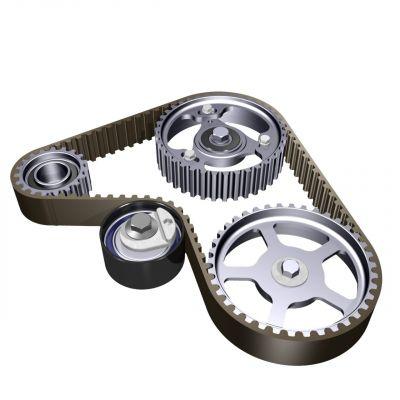
Introduction
Welcome to Pistonudos.com, where we are passionate about the motor world and we want to provide you with all the information you need. In this article, we will talk about the timing belt in a car, its function, when it is necessary to change it and how much the change can cost. We'll also mention other types of belts on an engine and give you tips on auxiliary belt maintenance. Read on for all the details!
What is the timing belt?
The timing belt is a fundamental part of a car engine. It is a rubber band or synthetic material that is responsible for synchronizing the movement of the intake and exhaust valves with the movement of the crankshaft and the camshaft. Its main function is to ensure that the valves open and close at the right time, allowing the engine to run properly.
How does the timing belt work?
The timing belt is connected to the crankshaft and camshaft, and its movement is transmitted through toothed pulleys. These pulleys are synchronized with the engine's valves, so when the crankshaft turns, the belt turns as well, which in turn turns the camshaft. This allows the valves to open and close at the right time, ensuring the correct intake of air and fuel, as well as the expulsion of exhaust gases.
When do you have to change the timing belt?
The timing belt is a part that suffers wear over time and use. There is no fixed change interval for all makes and models of cars, so it is important to consult the manufacturer's manual for specific recommendations. However, in most cases, it is recommended to change the timing belt between 80.000 and 120.000 kilometers or every 5 years, whichever comes first. It is important to note that if the belt breaks it can cause serious damage to the engine, so it is essential to change at the right time.
How much does a timing belt change cost?
The cost of changing the timing belt may vary depending on the car model, the brand and the workshop where the service is performed. In general, the price can range between 300 and 600 euros, including labor and the necessary materials. It's important to remember that this is preventative maintenance that can prevent costly engine breakdowns, so it's worth investing in a timing belt change.
Other types of belts in an engine
In addition to the timing belt, there are other types of belts on an engine that also serve important functions. One of them is the auxiliary strap, also known as an accessory strap. This belt is responsible for transmitting the energy from the crankshaft to the different components of the engine, such as the alternator, the water pump, the air conditioning compressor, among others. It is essential to check and maintain the auxiliary belt in good condition, since its breakage can cause the loss of operation of these components.
Auxiliary Belt Maintenance
To ensure proper functioning of the auxiliary belt, it is advisable to check its condition periodically. If cracks, excessive wear or abnormal noises are observed, it is necessary to replace it. Also, it is important to maintain proper tension, as a loose belt can slip and a belt that is too tight can damage components. If you do not have experience in this type of maintenance, it is advisable to go to a specialized workshop to carry out the necessary revision and adjustment.
Frequent questions
What happens if the timing belt is not changed in time?
If the timing belt is not changed in time, there is a high risk of it breaking while the engine is running. This can cause serious damage to valves, pistons, and other engine components. Repairing these damages can be expensive and in some cases, it may even be necessary to replace the entire engine. Therefore, it is essential to follow the manufacturer's recommendations and change the timing belt at the right time.
What is the difference between a timing belt and a timing chain?
The timing belt and timing chain are two systems used to synchronize the movement of the valves in relation to the crankshaft and camshaft. The main difference between the two is the material used and its durability. The timing belt is made of rubber or synthetic material and has a limited lifespan, so it must be replaced periodically. On the other hand, the timing chain is made of metal and is more resistant, so it does not require regular changing. However, the timing chain can be noisier and can be more expensive to replace if necessary.
Conclusion
In short, the timing belt is a fundamental part of a car engine, responsible for synchronizing the movement of the valves. It is important to change it at the right time to avoid costly engine damage. In addition, it is necessary to pay attention to the condition and maintenance of the auxiliary belt, which transmits power to the engine components. Remember to follow the manufacturer's recommendations and go to a specialized workshop to make the necessary changes and revisions. Take care of your car and keep its engine in good condition!
We hope this article has been useful and has resolved all your questions about the timing belt. If you have any additional questions or want to share your experience, feel free to leave us a comment. We will be happy to help you!
Until next time at Pistonudos.com!


























